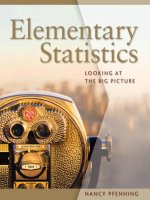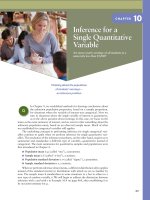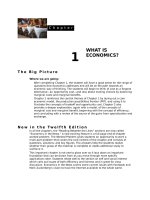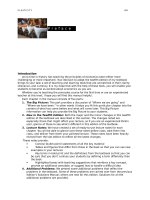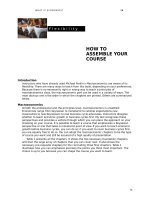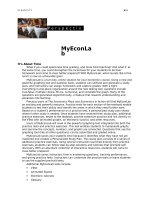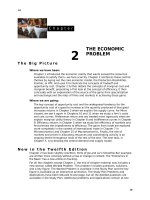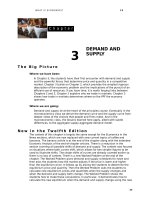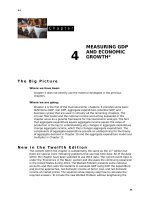The big picture marcoeconomics 12e parkin chapter 02
Bạn đang xem bản rút gọn của tài liệu. Xem và tải ngay bản đầy đủ của tài liệu tại đây (391.24 KB, 15 trang )
10
C h a p t e r
The Big Picture
2
THE ECONOMIC
PROBLEM
Where we have been:
Chapter 1 introduced the economic reality that wants exceed the resources
available to satisfy them—we face scarcity. Chapter 2 reinforces these central
themes by laying out the core economic model, the Production Possibilities
Frontier, or PPF, and uses it to illustrate the concepts of tradeoff and
opportunity cost. Chapter 2 further details the concepts of marginal cost and
marginal benefit, presenting a first look at the concept of efficiency. It then
concludes with an explanation of the source of the gains from specialization
and exchange and the roles of firms and markets in achieving those gains.
Where we are going:
The key concept of opportunity cost and the widespread tendency for the
opportunity cost of a good to increase as the quantity produced of that good
increases returns in Chapter 3 when we explain the supply curve. For Micro
classes, we see it again in Chapters 10 and 11 when we study a firm’s costs
and cost curves. Preferences return and are treated more rigorously when we
explain marginal utility theory in Chapter 8 and indifference curves in Chapter
9. Efficiency returns in Chapter 5 when we study the efficiency of markets and
first preview the impediments to efficiency. The gains from trade are explored
more completely in the context of international trade in Chapter 7 in
Microeconomics and Chapter 15 of Macroeconomics. Finally, the role of
markets and prices in allocating resources and coordinating activity is an
ongoing theme throughout most of the rest of the text. The next task, in
Chapter 3, is to develop the central demand and supply model.
N e w i n t h e Tw e l f t h E d i t i o n
Chapter 2 has been slightly rewritten. Parts of Joe and Liz’s Smoothie Bar example
are written more concisely without a loss or change in content. The “Economics in
the News” has a new article on fracking.
For all the chapters except Chapter 1, the end of chapter material now includes a
new section called Worked Problem. This problem includes questions, solutions,
and a key figure. The Worked Problem is available in the Study Plan and the key
figure is available as an interactive animation. The Study Plan Problems and
Applications have been reduced to one page, but all the deleted questions are
available in the Study Plan. Additional problems and Applications remain at two
10
11
pages. In this chapter the Worked Problem gives data for a production possibilities
frontier and then asks a variety of questions. The first question asks the students
if a combination of products is attainable and the second question asks if another
combination is efficient. The answers point out how the available resources limit
production. The next question asks if a combination of products has a tradeoff and
the last question asks the opportunity of increasing the production of a product.
The answers point out the relationship among production efficiency, tradeoff, and
opportunity cost.
11
Lecture Notes
The Economic Problem
Scarcity creates the need to make choices.
Economic choices can be evaluated in terms of their efficiency.
We can expand possible choices through capital accumulation and specialization
and trade.
I. Production Possibilities and Opportunity Cost
The production possibilities frontier (PPF) is the boundary between those
combinations of goods and services that can be produced and those that cannot
given available resources and technology.
Consider the production choices for two
goods: books and movies. The table with
the data for the PPF is below and a figure
showing the PPF is to the right.
A
B
C
D
Books
0
200
400
600
Movies
600
500
300
0
Production points beyond the PPF are not
attainable without increases in resources
or technology (these factors shift the PPF);
Production points on and within the PPF
are attainable, but production points within the PPF, such as point Z, are inefficient.
It is possible to get more of one good without giving up any of the other.
The PPF illustrates how scarcity creates the need to make choices. Producing more
books (moving from point A to point B) means producing fewer movies, and
producing more movies (moving from point C to point B) means producing fewer
books.
Using the PPF above, make a point outside the PPF and ask the students about it. Once they
state it is not possible, ask them how we could get there. After they highlight a few shifters,
summarize for them that the resources and technology we held constant when we drew the
PPF now relocate it when they change.
Now give them an example of a new movie camera invention and ask them if this will help
us get more books? You will likely get an immediate round of “NO.” Reply, “Are you sure?”
and you should be able to find a student who sees that the new resource frees up other
resources that can now be used for more books. Show them graphically a shift that is
pinned at the book axis and it will open their eyes to how technology and resource growth in
any sector can make more of all goods!
Production Efficiency
Production is efficient only on the frontier.
We achieve production efficiency if we cannot produce more of one good without
producing less of some other good.
Inside the frontier (point Z), production is inefficient. Resources could be better
employed to increase production of both books and movies.
THE ECONOMIC PROBLEM
Tradeoff Along the PPF
Moving along the PPF, there is always a tradeoff involved in diverting resources from
the production of one thing to another. We gain one thing but at the opportunity cost
of losing something else.
The key here is to make sure the student understands that given scarcity, because we
produce one thing, we cannot produce something else. Some students will see the tradeoff
immediately as a cost (giving up something), but they will incorrectly interpret that cost as
only that valued in money units. To eliminate this ambiguity (better now than later), ask
them to think about a meal they purchased recently. Now ask them what the money cost
was as well as what else they might have picked for a meal? Most students pick up on this
concept quickly with one or two more examples. And since this is a consumption example,
tell them to put themselves in the place of an office manager, who must produce a service
but can do so only given tradeoffs. While money costs are measurable and useful, propose
to the students that opportunity costs are indeed even more useful in identifying the
tradeoffs made in production.
Opportunity Cost
The opportunity cost of an action is the highest valued alternative forgone.
Efficiency means that the opportunity cost of producing more books or movies is the
tradeoff along the frontier.
Increasing Opportunity Costs
The “bowed-out” shape of the PPF reflects the principle of increasing opportunity
cost.
Not all resources are the same, which is why the PPF bows out. Publishers are better
at producing books and Hollywood studios are better at producing movies. Moving
along the frontier and producing more movies inevitably means that more and more
publishers must produce movies. As this happens, the increase in movies becomes
smaller and the decrease in books becomes larger.
Emphasize the intercepts where the PPF crosses the axes. Take the vertical intercept
in the figure. At this point all resources are used to produce movies. Basically to get
to that point the economy has crammed and slammed every resource into movie
production. Now when the economy moves down the PPF to produce the first book,
that book is really inexpensive—has very low opportunity cost—because the
economy uses resources better suited for book production first rather than movies.
As more and more resources are diverted from production of one good to another,
the smaller the additional increase in the production of the one good will be and the
larger the decrease in the production of the other good.
You can bring in the relationship of slope and opportunity cost here if you want. OPTION 1: A
soft way to bring in slope is to offer it as a double check on calculating marginal cost: “The
opportunity cost of whatever is being measured on the horizontal axis is equal to the
magnitude of the slope of the PPF.” OPTION 2: You can also introduce the slope of a curve as
the slope of a tangent line to the curve, that is, the slope of the line that is “just kissing” the
curve at a single point.
The bowed-out shape is a key feature of typical PPFs, often overlooked by the student (and
too often not accentuated by the instructor). The key here is to link the ever increasing
11
12
CHAPTER 2
opportunity cost exhibited by the shape of a bowed out PPF with that of the marginal cost
curve, which is upward sloping.
To make the PPF model useful, it was necessary to simplify. By considering the case where
production of all goods other than two remain fixed, we can use a relatively simple picture
to see how concepts apply to the real world. With three goods, we would have a 3-D frontier
surface. With more than 3 goods, it would be impossible to represent the frontier using a
graph. The cool thing is that all relevant results of the 2-D model are true in the N-good
model.
THE ECONOMIC PROBLEM
II. Using Resources Efficiently
Which point on the PPF best serves the public interest? To answer this question, we must
measure and compare costs and benefits of different points.
The PPF and Marginal Cost
Marginal cost is the opportunity cost of producing one more unit of a good.
As more books are produced, the marginal cost of a book increases. The table shows
the marginal cost of producing books from the PPF data presented before and the
figure shows the upward sloping
marginal cost curve.
Books
A
0
B
200
C
400
D
600
Marginal cost of
a book
(movies per
book)
0.5
1.0
1.5
Preferences and Marginal Benefit
Preferences are a description of a person’s likes and dislikes.
The marginal benefit of a good or services is the benefit received from consuming
one more unit of it.
The principle of decreasing marginal benefits is why the marginal benefit curve
in the figure above slopes downward.
You might have some students that have had a microeconomics course in their past, and
have already been introduced to the concept of marginal cost and marginal benefit. And,
they might inquire if the marginal benefit curve is linked to the Law of Diminishing Marginal
Utility. While this might be adequate discussion for an advanced undergraduate course, and
certainly a graduate micro seminar, pass it up in your principles course. Let the student
know that the goal is to employ demand side concepts, in a marginal sense. As such, key in
on the fact that the marginal benefit curve can be characterized as a willingness to pay
curve.
Keep the discussion of marginal cost and marginal benefit separate and distinct, making
sure that the student realizes these are in essence the foundation of market forces (supply
and demand, respectively). While the PPF can tell us the opportunity costs in production,
and the tradeoffs therein, it is the market that allows us to determine the allocatively
efficient point. Allocative efficiency only occurs with a balance between benefits and costs,
at the margin.
Allocative Efficiency
Allocative efficiency occurs only when marginal benefit equals marginal cost.
In the figure, when 100 books per month are produced, the marginal benefit from
another book exceeds its marginal cost, which means that people prefer another
book more than the movies they must give up.
When the allocatively efficient number of books, 200 per month, is produced, the
PPF in the previous figure shows that the allocatively efficient number of movies is
500 movies per month.
13
14
CHAPTER 2
When marginal cost equals marginal benefit it is impossible to make people better
off by reallocating resources.
THE ECONOMIC PROBLEM
III. Economic Growth
Economic growth expands production possibilities and shifts the PPF outward.
Technological change (the development of new goods and of better ways of
producing goods and services) and capital accumulation (the growth of capital
resources, which includes human capital) lead to economic growth.
You can have some fun and generate some discussion by getting the students to think
about what life might be like after another 200 years of economic growth. Provide some
numbers: In 2008, income per person in the United States was about $100 a day. In 1808 it
was about 70¢ a day, and if the past growth rate prevails for another 200 years, in 2208 it
will be $14,000 a day. Emphasize the magic of compound growth. If they think that $14,000
a day is a big income, get them to do a ballpark estimate of the daily income of Bill Gates
(about $10 million!). Encourage a discussion of why scarcity is still present even at these
large incomes.
The Cost of Economic Growth
Economic growth requires that resources must be devoted to developing technology
or accumulating capital, which means that current consumption decreases. The
decrease in current consumption is the opportunity cost of economic growth.
A Nation’s Economic Growth
Countries that devote a higher share of resources to developing technology or
accumulating capital are more likely to grow faster.
Some nations, such as Hong Kong, have chosen faster capital accumulation at the
expense of current consumption and so have experienced faster economic growth.
Running through the above example can really help students catch on to how economic
growth is linked to choices (less consumption now for more later). You may wish to
demonstrate more consumption or more capital biased shifts of the PPF, to demonstrate
changes in opportunity costs.
IV. Gains from Trade
Specialization and trade expand consumption possibilities
Comparative Advantage and Absolute
Advantage
A person has a comparative advantage in
an activity if that person can perform the
activity at a lower opportunity cost than
anyone else.
The PPF shows opportunity cost. In the figure
the opportunity cost of a bushel of wheat in
Canada is 1/4 of a computer and in Japan it is
1 computer. In Canada the opportunity cost of
a computer is 4 bushels of wheat and in Japan
it is 1 bushel of wheat. Canada has a
comparative advantage in producing wheat
and Japan has a comparative advantage in
producing computers.
A person has an absolute advantage if that person is more productive than others
in that activity or activities. A person (or country) can have an absolute advantage
in all activities but that person (or country) will not have a comparative advantage
in all activities.
15
16
CHAPTER 2
An easy way for students to remember the difference between comparative and absolute
advantages is that with comparative advantage, the opportunity costs comparison matters.
If one has a comparative advantage in producing something, they should specialize in
production of that good or service. An absolute advantage can be characterized by being
able to “absolutely out-produce” the other economic agent. Even though a country might
have absolute advantages, it should not produce everything, and should focus on
identifying its comparative advantages.
Achieving the Gains from Trade
When countries specialize by producing the
good in which each country has a
comparative advantage more goods in total
can be produced. If without trade Canada
and Japan each produce at point A, a total
of 8 computers and 16 bushels of wheat are
produced. If they specialize according to
comparative advantage, Japan produces at
point B* and Canada produces at point B for
a combined total of 12 computers and 24
bushels of wheat.
Trade allows consumption to be different
than production for each nation, so Canada
can trade wheat for computers and Japan
can trade computers for wheat. Because
more computers and more wheat are
produced, both nations can consume more than they can produce on their own. For
example, suppose that the market price of wheat is ½ computer per 1 bushel of
wheat. As illustrated, each country can now be consuming at point C along the trade
line. Note that each country’s consumption point lies beyond its own PPF.
The gains from trade can now be easily seen in terms of Japan and Canada each
gaining 2 computers and 4 bushels of wheat compared to their initial, no-trade
consumption points. Note that it is more likely that point C for each country will be
on a different point on the trade line according to preferences. In the end, the sum
of consumption among the two countries must equal the sum of production
(imports=exports). For simplicity, this example has points A and C equal for both
countries.
You may want to motivate the gains from trade using an example loosely based on Tom
Hanks in the movie Castaway. Ask the students, “Was Tom by himself on the island an
economy?” Use a couple goods like fish and coconuts and show Tom’s production
possibilities. Discuss what are the essential elements needed to have an economy. Tom
produces food and then he consumes it but is this sufficient for us to call him an economy?
It is an open-ended question that I end with Tom needing somebody to trade with. Once a
new person washes up on shore, the two can specialize in the good for which he or she has
a comparative advantage and trade for the other. Give one of them an absolute advantage
and then show how consumption possibilities lie outside each person’s production
possibilities. This shows the power of specialization and trade in a way that personalizes it
for the student.
V. Economic Coordination
Firms and Markets
A firm is an economic unit that hires factors of production and organizes those
factors to produce and sell goods and services.
THE ECONOMIC PROBLEM
A market is any arrangement that enables buyers and sellers to get information
and to do business with each other.
Property Rights and Money
The social arrangements that govern the ownership, use, and disposal of resources,
goods, and services are called property rights. Types of property include real
(buildings and land), financial (stocks and bonds) and intellectual (ideas and
technology).
Money is anything generally accepted as a means of payment. Money’s main
purpose is to facilitate trade.
Students are usually fixated on money, but ask them to dig deeper. It is what we can do or
buy with money that brings us happiness not the actual bills themselves.
Circular Flows Through Markets
Firms and households interact in markets and it is this interaction that determines
what will be produced, how it will be produced, and who will get it.
Coordinating Decisions
Prices within markets coordinate firms’ and households’ decisions.
Everyone knows what prices are. But not everyone knows why prices rise or fall. The point is
that no one needs to know why a price has changed when making the choice to buy or sell.
All that someone needs to know is what the price is relative to what he or she believes the
item to be worth.
Enforced property rights ensure that exchange is voluntary (not theft). Property
rights and prices help insure that production takes place efficiently without waste
because the owner of a firm has the property right to any profit the firm can earn.
Willingness to pay affects production and production affects willingness to pay. It would
appear that we have the classic “which came first, the chicken or the egg” conundrum.
However, in the next chapter, we will discuss the most powerful model in economics,
Demand and Supply, which allows us to think clearly about the behavior of markets.
17
18
CHAPTER 2
Additional Problems
1.
2.
3.
4.
Jane’s Island’s production possibilities are given
in the table to the right.
a. Draw a graph of the production possibility
possibilities frontier on Jane’s Island.
b. What are Jane’s opportunity costs of producing
corn and cloth at each output in the table?
Corn
(pounds
per
month)
3.0
2.0
1.0
0
and
and
and
and
Cloth
(yards
per
month)
0
2
4
6
In problem 1, Jane is willing to give up 0.75
pounds of corn per yard of cloth if she has 2
yards of cloth; 0.50 pounds of corn per yard of
cloth if she has 4 yards of cloth; and 0.25 pound of corn per yard of cloth if
she has 6 yards of cloth.
a. Draw a graph of Jane’s marginal benefit from corn.
b. What is Jane’s efficient quantity of corn?
Joe’s production possibilities are given in the
table to the right. What are Joe’s opportunity
costs of producing corn and cloth at each
output in the table?
Corn
(pound
s per
month)
Cloth
(yards
per
month
)
0
1.0
2.0
3.0
In problems 1 and 2, Jane’s Island produces
6
and
and consumes 2 pounds of corn and 2 yards of
4
and
cloth. Joe’s Island produces and consumes 2
2
and
pounds of corn and 2 yard of cloth. Now the
0
and
islands begin to trade.
a. What good does Jane sell to Joe and what
good does Jane buy from Joe?
b. If Jane and Joe divide the total output of corn and cloth equally, what are the
gains from trade?
Solutions to Additional Problems
1. a. Jane’s Island’s PPF is a straight line. To
make a graph of Jane’s Island’s PPF
measure the quantity of one good on the xaxis and the quantity of the other good on
the y-axis. Plot the quantities in each row of
the table. Figure 2.1 illustrates Jane’s
Island’s PPF.
b. The opportunity cost of 1 pound of corn is 2
yards of cloth. The opportunity cost of the
first pound of corn is 2 yards of cloth. To find
the opportunity cost of the first pound of
corn, increase the quantity of corn from 0
pounds to 1 pound. In doing so, Jane’s
Island’s production of cloth decreases from
6 yards to 4 yards. The opportunity cost of
the first pound of corn is 2 yards of cloth.
Similarly, the opportunity costs of
producing the second pound and the third pound of corn are 2 yards of cloth.
THE ECONOMIC PROBLEM
The opportunity cost of 1 yard of cloth is 0.5 pound of corn. The opportunity cost of
producing the first 2 yards of cloth is 1 pound of corn. To calculate this opportunity
cost, increase the quantity of cloth from 0 yards to 2 yards. Jane’s Island’s
production of corn decreases from 3 pounds to 2 pounds. Similarly, the opportunity
cost of producing the second 2 yards and the third 2 yards of cloth are 1 pound of
corn.
2. a. The marginal benefit curve slopes
downward. To draw the marginal benefit
curve from cloth, plot the quantity of cloth
on the x-axis and the willingness to pay for
cloth (that is, the number of pounds of corn
that Jane is willing to give up to get a yard
of cloth) on the y-axis, as illustrated in
Figure 2.2.
b. The efficient quantity is 4 yards a month.
The efficient quantity to produce is such
that the marginal benefit from the last yard
equals the opportunity cost of producing it.
The opportunity cost of a yard of cloth is 0.5
pound of corn. The marginal benefit of the
fourth yard of cloth is 0.5 pound of corn.
And the marginal cost of the fourth yard of
cloth is 0.5 pound of corn.
3.
Joe’s Island’s opportunity cost of a pound of corn is 1/2 yard of cloth, and its
opportunity cost of a yard of cloth is 2 pounds of corn. When Joe’s Island increases the
corn it produces by 2 pounds a month, it produces 1 yard of cloth less. The opportunity
cost of 1 pound of corn is 1/2 yard of cloth. Similarly, when Joe’s Island increases the
cloth it produces by 1 yard a month, it produces 2 pounds of corn less. The opportunity
cost of 1 yard of cloth is 2 pound of corn.
4. a. Jane’s Island sells cloth and buys corn. Jane’s Island sells the good in which it has a
comparative advantage and buys the other good from Joe’s Island. Jane’s Island’s
opportunity cost of 1 yard of cloth is 1/2 pound of corn, while Joe’s Island’s
opportunity cost of 1 yard of cloth is 2 pounds of corn. Jane’s Island’s opportunity
cost of cloth is less than Joe’s Island’s, so Jane’s Island has a comparative advantage
in producing cloth.
Jane’s Island’s opportunity cost of 1 pound of corn is 2 yards of cloth, while Joe’s
Island’s opportunity cost of 1 pound of corn is 1/2 yard of cloth. Joe’s Island’s
opportunity cost of corn is less than Jane’s Island’s, so Joe’s Island has a comparative
advantage in producing corn.
b. With specialization and trade, together they can produce 6 pounds of corn and 6
yards of cloth and each will get 3 pounds of corn and 3 yards of cloth—an additional
1 pound of corn each and an additional 1 yard of cloth each. Hence the total gains
from trade are 2 yards of cloth and 2 pounds of corn.
Additional Discussion Questions
1. Use the PPF model to analyze an “Arms Race” between nations. You
might like to get the students to realize how useful even a simple economic
19
20
CHAPTER 2
model (such as the PPF model) is for helping us understand and interpret
important political events in history. Draw a PPF for military goods and civilian
goods production (or, simply, the traditional example of “guns versus butter”).
Then draw another PPF for a country that is about twice the size of the first,
but with the same degree of concavity as the PPF for the first country. Now
assume that each country considers the other as a mortal “enemy,” and that
they engage in a costly “arms race.” Each country picks a point on the PPF
that produces an equal level of military output (in absolute terms).
What would happen if the larger country decided to increase military
production? Emphasize that while the distance on the military output axis at
the point of production is equal for both countries, the resulting distance on
the civilian output axis is (by definition) a smaller quantity for the smaller
country. The large country can create significant economic and political
pressures on the government of the small country by forcing the small country
to match the increase in military production. The PPF reveals how much more
additional civilian output is forgone by the citizens of the small economy
relative to the citizens of the larger economy. Emphasize also that the
opportunity cost of civilian goods is higher for the smaller country.
What were the economic repercussions of the Cold War? History and
political science majors quickly perceive that these two PPF models reflect the
Cold War relationship between the United States and the U.S.S.R. during the
early 1980s. The Reagan administration increased U.S. military expenditures
during the early 1980s to a post–Viet Nam War peak of 6.6 percent of GDP (as
compared to about 3.5 percent of GDP in the late 1990s). Many experts agree
that this strategy contributed to the many political and economic pressures
that ultimately lead to the dissolution of the U.S.S.R.
What are the implications for the next 50 years? China is currently the
world’s second largest economy. It could become the biggest by mid-century.
How does this development influence the strategic balance and the position of
the United States?
12. Using the PPF model to analyze global environmental agreements
between nations. This application of the PPF is a more “green” perspective
that uses the same logic as the “Arms Race” on a timely international policy
issue. Compare a rich economy PPF to a poor economy PPF, each with the
same degree of concavity. (Production levels are now measured as output per
person.) The goods are now “cleaner air” and “other goods and services.”
What if the citizens of each country were required to make equal
reductions in per-person greenhouse gas emissions? Show an equal
quantity increase in per person output on the clean air axis for both countries’
PPF curves. Show how the opportunity cost of requiring additional pollution
reduction (cleaner air) of equal amounts per person is much greater for the
citizens of a poorer country than for the citizens of the richer country. This fact
has been used to persuade developed countries (like the United States) to
accept larger pollution reduction targets than developing countries (like China,
India, and African nations).
3. Why do some of the brightest
students not get a 4.0 GPA? The answer
—because it doesn’t achieve allocative
efficiency—can now be approached. The
first conceptual step is to derive the
marginal cost curve from the PPF. The table
provides eight points on the MC curve. Tell
Recreatio
n
(hours per
day)
0.5
1.5
2.5
3.5
4.5
5.5
6.5
7.5
Marginal cost
(GPA points per
hour)
0.1
0.2
0.3
0.4
0.5
0.6
0.7
0.8
THE ECONOMIC PROBLEM
the students that this table is from a PPF between hours spent at recreation
and GPA. Use this opportunity to explain why we plot marginal values at the
midpoints of changes because the marginal cost at the midpoint approximately
equals the average of the opportunity costs across the interval.
The students must now think about preferences for recreation and study. You’ll
be surprised how many students want to derive preferences from the PPF!
Explain that the PPF provides the constraint—what is feasible—and
preferences provide the objective—what is desirable in the opinion of the
chooser.
Willingness
Each additional hour of recreation likely
Recreatio
to pay
yields a smaller marginal benefit to the
n
(GPA
points per
student. Translate this to the proposition
(hours per
hour)
that the student’s willingness to give up
day)
GPA points for additional hours of
0.5
0.7
recreation decreases and provide a table
1.5
0.6
similar to that in Figure 2.3 that captures
2.5
0.5
this observation. The table has a preference
3.5
0.4
schedule. Stress once again that this table
4.5
0.3
did not come from the PPF.
5.5
0.2
To determine the efficient amount of
6.5
0.1
recreation and hence study time, the
7.5
0
student must ask “Do I study a little bit
longer?” That is the question. Walk the student through the thought
experiment:
1. If I study for 8 hours a day I get a 4.0, but I am willing to pay much more
than I will pay if a take a bit of time off studying and have some fun. So I
will be better off if study less and take more recreation time.
2. If I don’t study at all I get a 0.4, and I am paying much more in lost GPA
than I am willing to pay for the last bit of fun. So I will be better off if I study
more and take less recreation time.
3. The only allocation at which I can’t become better off by studying a little bit
more or a little bit less is where I am just willing to pay what the last bit of
recreation costs—where marginal cost equals marginal benefit.
In this example, the student studies for 4.5 hours and takes 3.5 hours a week
of recreation time.
Explain that there is nothing strange or wrong with the fact that the student
gets no net benefit from the last seconds-worth of recreation time. He or she is
just willing to pay what it costs him or her.
4. Gains from Trade The gain from trade is a real eye-opener for students. Their
first reaction is one of skepticism. Convincing students of the power of trade to
raise living standards and the costs of trade restriction is one of the most
productive things we will ever do. Here are some questions to drive home the
idea of comparative advantage:
Why didn’t Billy Sunday do his own typing? Billy Sunday, an evangelist in
the 1930s, was reputed to be the world’s fastest typist. Nonetheless, he
employed a secretary who was a slower typist than he. Why? Because in one
hour of preaching, Billy could raise several times the revenue that he could
raise by typing for an hour. So Billy plays to his comparative advantage.
Why doesn’t Martha Stewart bake her own bread? Martha Stewart is
probably a better cook than most people, but she is an even better writer and
21
22
CHAPTER 2
TV performer on the subject of food. So Martha plays to her comparative
advantage and writes about baking bread but buys her bread.
Why doesn’t Vinnie Jones play soccer? Vinnie Jones was one of the world’s
best soccer players. But he stopped playing soccer and started making movies
some years ago. Why? Because, as he once said, “You go to the bank more
often when you’re in movies.” Vinnie’s comparative advantage turned out to
be in acting.
